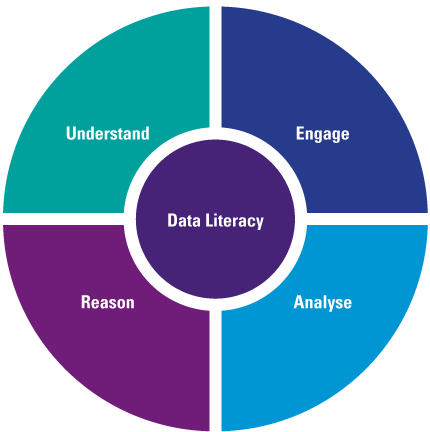By- Zaheer Khaled, Principal Consultant at Capco, and Chris Probert, Partner UK Data Practice Lead at Capco
In a digital world with exponential technological advancements, the ability to comprehend and communicate a common data language is a vital skill for organizations today. Data literacy has therefore become a key component for organizations and is the ability to read, analyze, utilize, and communicate data. Despite this, on average, companies make only 48 percent of decisions based on quantitative information and analysis – a number that has not moved a great deal over the past couple of years due to a lack of skills at all levels, and as a result, is impeding their transformation into becoming an insights-driven organization.
A data-literate organization is critical to minimize new risks that arise from data not being correctly handled. There are many recent examples of large organizations being fined tens of millions by regulators due to a lack of data literacy. In this increasingly digital and regulated financial landscape, the demand for data literacy is not going to abate, it will continue to grow. It is time for organizations to make sure they have the tools to unlock their value.
The meaning and importance of Data literacy
Data literacy is the ability to read, analyze, utilize, and communicate data. Data literacy can be broken down into two key dimensions, firstly as an organization and through its people. These dimensions complement one another and empower firms to ask the right questions, build knowledge, make effective decisions, and most importantly, cultivate a data capability among individuals.
Being a data-literate organization is critical today to drive innovation, growth, and profits. A data literate organization is also key to minimizing new risks that may arise from data not being correctly handled. In the current digital world, customers expect real-time, easy-to-use, personalized services that require a more customer-centric, technology and data-led approach for servicing. A data-literate organization is fundamental in minimizing new risks that arise from data not being correctly handled to contain costs that arise from the changing technology landscape and grow new data-driven avenues for business.
However, companies are struggling to become insights-driven organizations. International Data Corporation, a global provider of market intelligence forecasts a ten-fold increase in worldwide data by2025.2 It is expected that by the end of 2025, 59 zettabytes of data would have been produced in the world.3 Organizations will naturally produce a vast amount of data, for which data literate employees will be required to contribute more to their roles and help businesses to sharpen their competitive edge. Ninety-four percent of people using data in their current role agree data helps them do their jobs better and they also believe greater data literacy would give them more credibility (82 percent) in theworkplace.4 Data literacy is hence crucial as it not only can transform an organization but also builds loyalty witha workforce, empowered by the investment in their professional development.
How to understand your organization’s current state of data literacy
We have studied many high-performing data-literate companies. We believe the best ones have tailored their learning and development for the diversity of their workforce. However, we believe no organization has yet reached a ‘data literacy utopia’ in Stage 3: Data fluency – where any organization can disrupt learning platforms and enhance data literacy outwards, potentially impacting positive socioeconomic change. We have outlined the journey to fluency in climbing the data literacy ladder but beware of the pitfalls!
STAGE 1: PROFILE Understand your organization’s current state and answer the following questions:
- What is our baseline and what skills do we have?
- Are we championing data and success?
- Where are our power users?
- Are citizen data scientists realistic in our organization?
- What are our interactions?
- Do we have the right career paths in our organization to attract the right talent?
- Where is our talent?
- How many of our decisions are based on data?
STAGE 2: Accelerate & Reinforcement data literacy throughout your organization
Now that you have strong data literacy initiatives embedded into your departments and these are running effectively, you should then think about:
- Monitoring and gathering data points: continuously track current data literacy and improvements with well-established KPIs
- Solidifying partnerships with institutions to bring best-in-class thinking
- Continuously evaluating new technology and techniques to train people
- Developing omnichannel training programs: gamify, peer to peer, and competitions to cater to different learning, cultural, and neuro diversities.
STAGE 3: Data Fluency
Your data literacy initiatives have become world-class and disrupted established learning platforms and institutions. Here are some things to consider as you become data fluent as an organization:
- ‘Data translators’ will not be needed, as people become more literate and organizational data is now democratized
- You can monetize your training capabilities as a service and platform
- Engage via social learning platforms which include competitions and sandbox environments where people compete socially to build the best new trading algorithms and machine learning models to help generate new revenue opportunities to improve your business
CONCLUSION-
The ability to comprehend and communicate a common data language is a core necessary skill for organizations. Data literacy has become a key component for organizations – and should not be considered as the remit of just one team, but the responsibility of an organization of data-literate people. A data-literate organization is critical to minimize new risks that arise from data not being correctly handled, contain costs that arise from the changing technology landscape, and grow new data-driven avenues for business. We believe the best organizations have tailored their learning and development for the diversity of their workforce. Achieving long-lasting data literacy in your organization is not just about having best-in-class learning and development initiatives. It is imperative to identify Risks early and mitigate them, and most importantly use culture as a mechanism to make them stick.
—xxx—




















